Case Study: Aging Aircraft Issues and Challenges in Australia
VerifiedAdded on 2020/04/01
|15
|4747
|101
Report
AI Summary
This report presents a detailed analysis of the challenges associated with aging aircraft in Australia. It begins with an introduction to the issues, emphasizing the impact of time, usage, and obsolescence on aircraft. The study investigates management problems, including inventory maintenance, technical advancements, cost minimization, and risk mitigation. The report analyzes demographic data, including age, years of experience, and education levels of respondents, derived from a survey of aviation professionals. It addresses research questions related to probabilistic and deterministic metrics, risk assessment, quality assurance, structural integrity, and the impact of accidents. The analysis references various case studies and expert opinions, covering topics such as electronic wiring, wire failure probability, and the effects of accidents on aviation safety development. The report also explores issues in Nigeria, offshoring and outsourcing, damage detection concepts, corrosion fatigue mechanisms, and lap-joint inspection techniques. It concludes with a discussion of the characteristics, occurrences, and causes of aircraft accidents, as well as problems and challenges related to aviation safety, drawing from economic literature analysis. The report provides a comprehensive overview of the complexities and multifaceted challenges of aging aircraft within the Australian aviation context.

CHAPTER 4
4.0 Introduction to the chapter
Aging aircraft issues has caused a lot of issues to many aircraft in Australia. These problems are
mainly or due to frame of time, the usage and the factors such as obsolescence (Iyyer1, 2008).
Management problems that faces the operators of aging aircrafts in Australia are:
How to maintain the inventory and readiness of operational requirements?
Maximizing the latest technical advances and minimizing the cost of impact?
The need for ensuring any age related problems prediction and mitigation by ensuring fleet
safety and ways of minimizing the risks associated.
What is required for keeping the Aging Aircraft to be always in service beyond goals designed
originally.
This chapter introduces us the analysis of the case study. This may be explained in reference to the
demographic or the population working within aviation area with wide knowledge in Aircraft. The
analysis is with reference to what the data of the population entails that is in terms of the
respondent’s profiles taking in to consideration the age, years of experience and the level of
education. Also the research questions will be answered with reference to what our respondents will
answer us. The last section is a brief summary of what this chapter will discuss.
4.1 Demographic data analysis.
Demographic analysis in terms of data and with relation to our case study Aging aircraft issues can be
explained as the technique that will be used so that we can develop an understanding of the age,
based sex, and the decomposition of race in a population and how this has been influenced or
altered over specified time through the basic processes of demographic that is birth, death and
migration in total (Census.gov, 2010). In chapter three we discussed the research design in details
where data analysis was done in an effective way that is in terms of quantitative data collection
method. The research uses the primary data collection wherein the survey became conducted by
usage of a well-established questionnaire meant for 10 plane producers and 10 aviation enterprise
specialists chosen purposively for the research. A total of 20 respondents who were questioned in
form of answering a questionnaire booklet where 49% were female and 51% were male. All the
respondents were aged 18 and above and the large number were aged that is between 30 to 55
years totalling to 70%. 75% had attained masters or above in their education level. 60% were
employed on fulltime basis while the other 40% were on part time workers. This survey covered
4.0 Introduction to the chapter
Aging aircraft issues has caused a lot of issues to many aircraft in Australia. These problems are
mainly or due to frame of time, the usage and the factors such as obsolescence (Iyyer1, 2008).
Management problems that faces the operators of aging aircrafts in Australia are:
How to maintain the inventory and readiness of operational requirements?
Maximizing the latest technical advances and minimizing the cost of impact?
The need for ensuring any age related problems prediction and mitigation by ensuring fleet
safety and ways of minimizing the risks associated.
What is required for keeping the Aging Aircraft to be always in service beyond goals designed
originally.
This chapter introduces us the analysis of the case study. This may be explained in reference to the
demographic or the population working within aviation area with wide knowledge in Aircraft. The
analysis is with reference to what the data of the population entails that is in terms of the
respondent’s profiles taking in to consideration the age, years of experience and the level of
education. Also the research questions will be answered with reference to what our respondents will
answer us. The last section is a brief summary of what this chapter will discuss.
4.1 Demographic data analysis.
Demographic analysis in terms of data and with relation to our case study Aging aircraft issues can be
explained as the technique that will be used so that we can develop an understanding of the age,
based sex, and the decomposition of race in a population and how this has been influenced or
altered over specified time through the basic processes of demographic that is birth, death and
migration in total (Census.gov, 2010). In chapter three we discussed the research design in details
where data analysis was done in an effective way that is in terms of quantitative data collection
method. The research uses the primary data collection wherein the survey became conducted by
usage of a well-established questionnaire meant for 10 plane producers and 10 aviation enterprise
specialists chosen purposively for the research. A total of 20 respondents who were questioned in
form of answering a questionnaire booklet where 49% were female and 51% were male. All the
respondents were aged 18 and above and the large number were aged that is between 30 to 55
years totalling to 70%. 75% had attained masters or above in their education level. 60% were
employed on fulltime basis while the other 40% were on part time workers. This survey covered
Paraphrase This Document
Need a fresh take? Get an instant paraphrase of this document with our AI Paraphraser
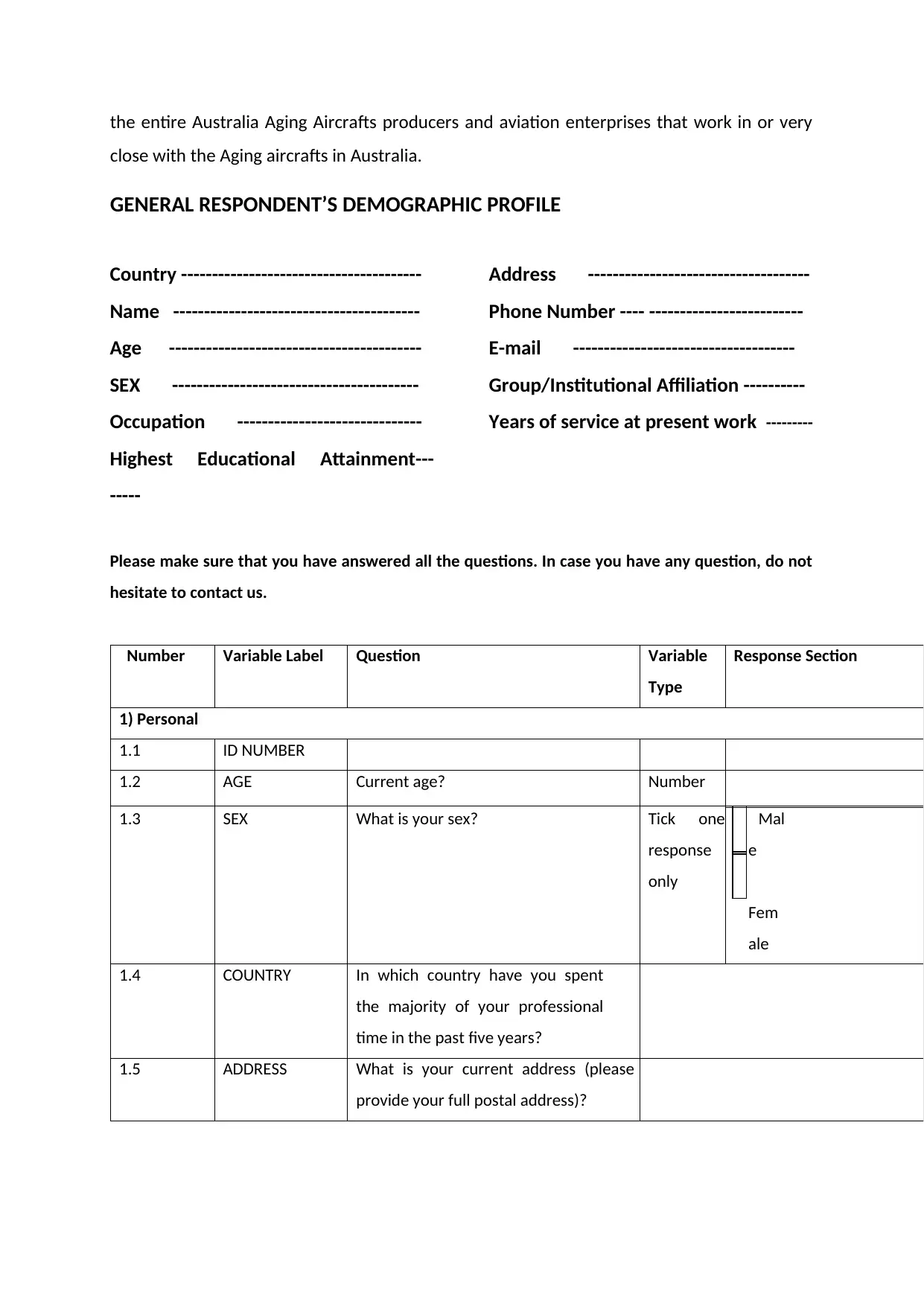
the entire Australia Aging Aircrafts producers and aviation enterprises that work in or very
close with the Aging aircrafts in Australia.
GENERAL RESPONDENT’S DEMOGRAPHIC PROFILE
Country ---------------------------------------
Name ----------------------------------------
Age -----------------------------------------
SEX ----------------------------------------
Occupation ------------------------------
Highest Educational Attainment---
-----
Address ------------------------------------
Phone Number ---- -------------------------
E-mail ------------------------------------
Group/Institutional Affiliation ----------
Years of service at present work ---------
Please make sure that you have answered all the questions. In case you have any question, do not
hesitate to contact us.
Number Variable Label Question Variable
Type
Response Section
1) Personal
1.1 ID NUMBER
1.2 AGE Current age? Number
1.3 SEX What is your sex? Tick one
response
only
Mal
e
Fem
ale
1.4 COUNTRY In which country have you spent
the majority of your professional
time in the past five years?
1.5 ADDRESS What is your current address (please
provide your full postal address)?
close with the Aging aircrafts in Australia.
GENERAL RESPONDENT’S DEMOGRAPHIC PROFILE
Country ---------------------------------------
Name ----------------------------------------
Age -----------------------------------------
SEX ----------------------------------------
Occupation ------------------------------
Highest Educational Attainment---
-----
Address ------------------------------------
Phone Number ---- -------------------------
E-mail ------------------------------------
Group/Institutional Affiliation ----------
Years of service at present work ---------
Please make sure that you have answered all the questions. In case you have any question, do not
hesitate to contact us.
Number Variable Label Question Variable
Type
Response Section
1) Personal
1.1 ID NUMBER
1.2 AGE Current age? Number
1.3 SEX What is your sex? Tick one
response
only
Mal
e
Fem
ale
1.4 COUNTRY In which country have you spent
the majority of your professional
time in the past five years?
1.5 ADDRESS What is your current address (please
provide your full postal address)?
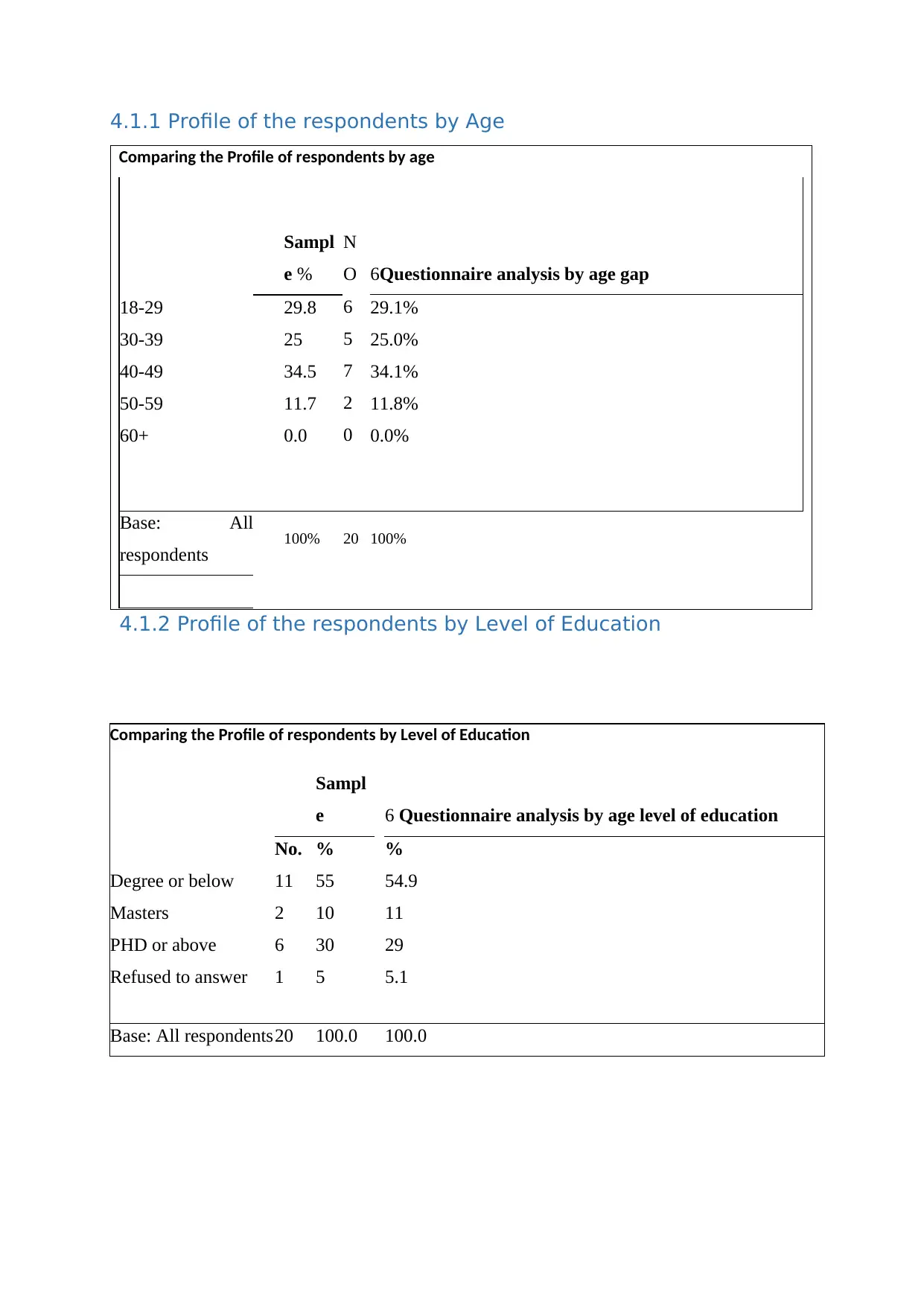
4.1.1 Profile of the respondents by Age
Comparing the Profile of respondents by age
Sampl
e %
N
O Questionnaire analysis by age gap
18-29 29.8 6 29.1%
30-39 25 5 25.0%
40-49 34.5 7 34.1%
50-59 11.7 2 11.8%
60+ 0.0 0 0.0%
Base: All
respondents 100% 20 100%
4.1.2 Profile of the respondents by Level of Education
Comparing the Profile of respondents by Level of Education
Sampl
e Questionnaire analysis by age level of education
No. % %
Degree or below 11 55 54.9
Masters 2 10 11
PHD or above 6 30 29
Refused to answer 1 5 5.1
Base: All respondents20 100.0 100.0
Comparing the Profile of respondents by age
Sampl
e %
N
O Questionnaire analysis by age gap
18-29 29.8 6 29.1%
30-39 25 5 25.0%
40-49 34.5 7 34.1%
50-59 11.7 2 11.8%
60+ 0.0 0 0.0%
Base: All
respondents 100% 20 100%
4.1.2 Profile of the respondents by Level of Education
Comparing the Profile of respondents by Level of Education
Sampl
e Questionnaire analysis by age level of education
No. % %
Degree or below 11 55 54.9
Masters 2 10 11
PHD or above 6 30 29
Refused to answer 1 5 5.1
Base: All respondents20 100.0 100.0
⊘ This is a preview!⊘
Do you want full access?
Subscribe today to unlock all pages.

Trusted by 1+ million students worldwide
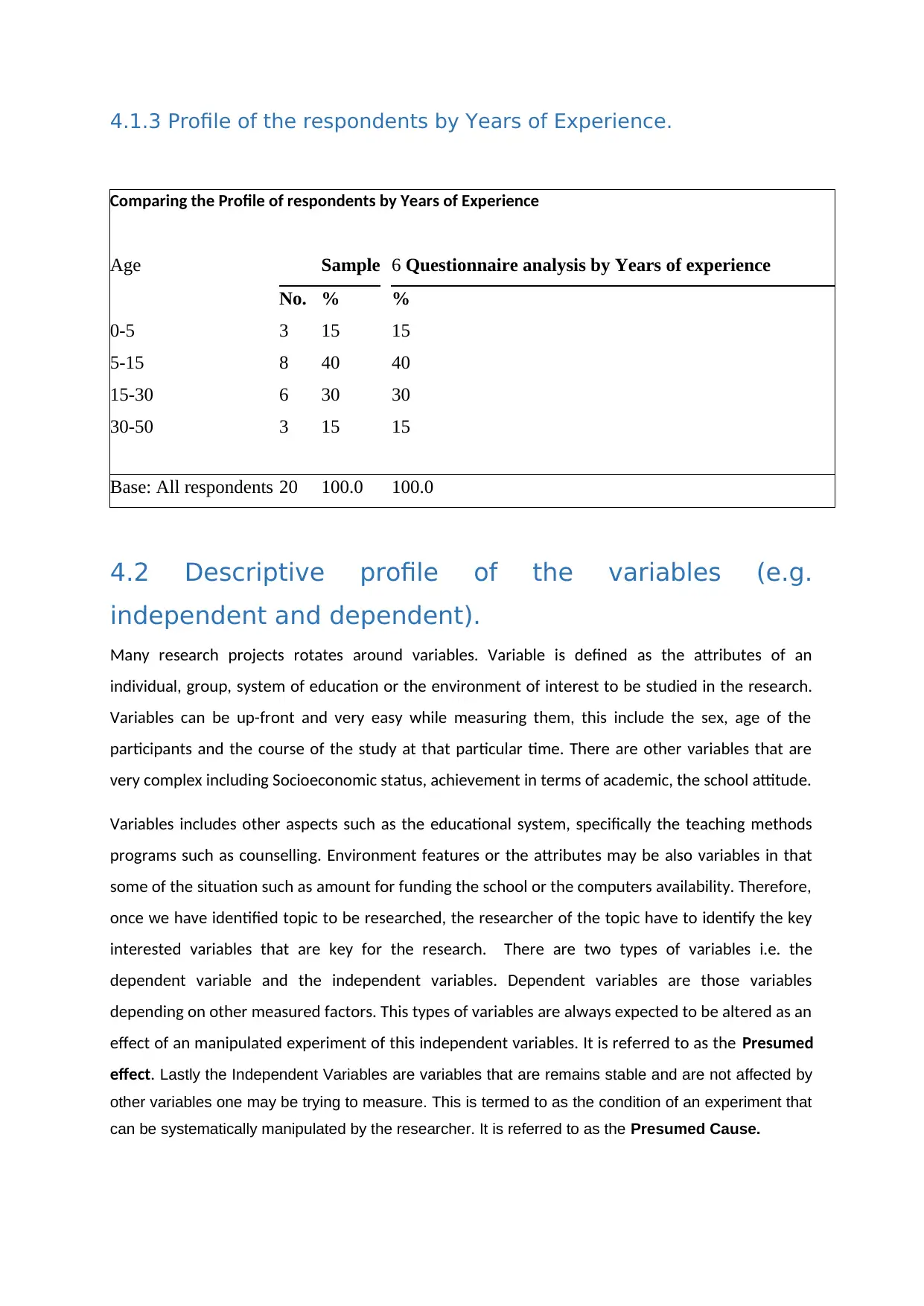
4.1.3 Profile of the respondents by Years of Experience.
Comparing the Profile of respondents by Years of Experience
Age Sample Questionnaire analysis by Years of experience
No. % %
0-5 3 15 15
5-15 8 40 40
15-30 6 30 30
30-50 3 15 15
Base: All respondents 20 100.0 100.0
4.2 Descriptive profile of the variables (e.g.
independent and dependent).
Many research projects rotates around variables. Variable is defined as the attributes of an
individual, group, system of education or the environment of interest to be studied in the research.
Variables can be up-front and very easy while measuring them, this include the sex, age of the
participants and the course of the study at that particular time. There are other variables that are
very complex including Socioeconomic status, achievement in terms of academic, the school attitude.
Variables includes other aspects such as the educational system, specifically the teaching methods
programs such as counselling. Environment features or the attributes may be also variables in that
some of the situation such as amount for funding the school or the computers availability. Therefore,
once we have identified topic to be researched, the researcher of the topic have to identify the key
interested variables that are key for the research. There are two types of variables i.e. the
dependent variable and the independent variables. Dependent variables are those variables
depending on other measured factors. This types of variables are always expected to be altered as an
effect of an manipulated experiment of this independent variables. It is referred to as the Presumed
effect. Lastly the Independent Variables are variables that are remains stable and are not affected by
other variables one may be trying to measure. This is termed to as the condition of an experiment that
can be systematically manipulated by the researcher. It is referred to as the Presumed Cause.
Comparing the Profile of respondents by Years of Experience
Age Sample Questionnaire analysis by Years of experience
No. % %
0-5 3 15 15
5-15 8 40 40
15-30 6 30 30
30-50 3 15 15
Base: All respondents 20 100.0 100.0
4.2 Descriptive profile of the variables (e.g.
independent and dependent).
Many research projects rotates around variables. Variable is defined as the attributes of an
individual, group, system of education or the environment of interest to be studied in the research.
Variables can be up-front and very easy while measuring them, this include the sex, age of the
participants and the course of the study at that particular time. There are other variables that are
very complex including Socioeconomic status, achievement in terms of academic, the school attitude.
Variables includes other aspects such as the educational system, specifically the teaching methods
programs such as counselling. Environment features or the attributes may be also variables in that
some of the situation such as amount for funding the school or the computers availability. Therefore,
once we have identified topic to be researched, the researcher of the topic have to identify the key
interested variables that are key for the research. There are two types of variables i.e. the
dependent variable and the independent variables. Dependent variables are those variables
depending on other measured factors. This types of variables are always expected to be altered as an
effect of an manipulated experiment of this independent variables. It is referred to as the Presumed
effect. Lastly the Independent Variables are variables that are remains stable and are not affected by
other variables one may be trying to measure. This is termed to as the condition of an experiment that
can be systematically manipulated by the researcher. It is referred to as the Presumed Cause.
Paraphrase This Document
Need a fresh take? Get an instant paraphrase of this document with our AI Paraphraser
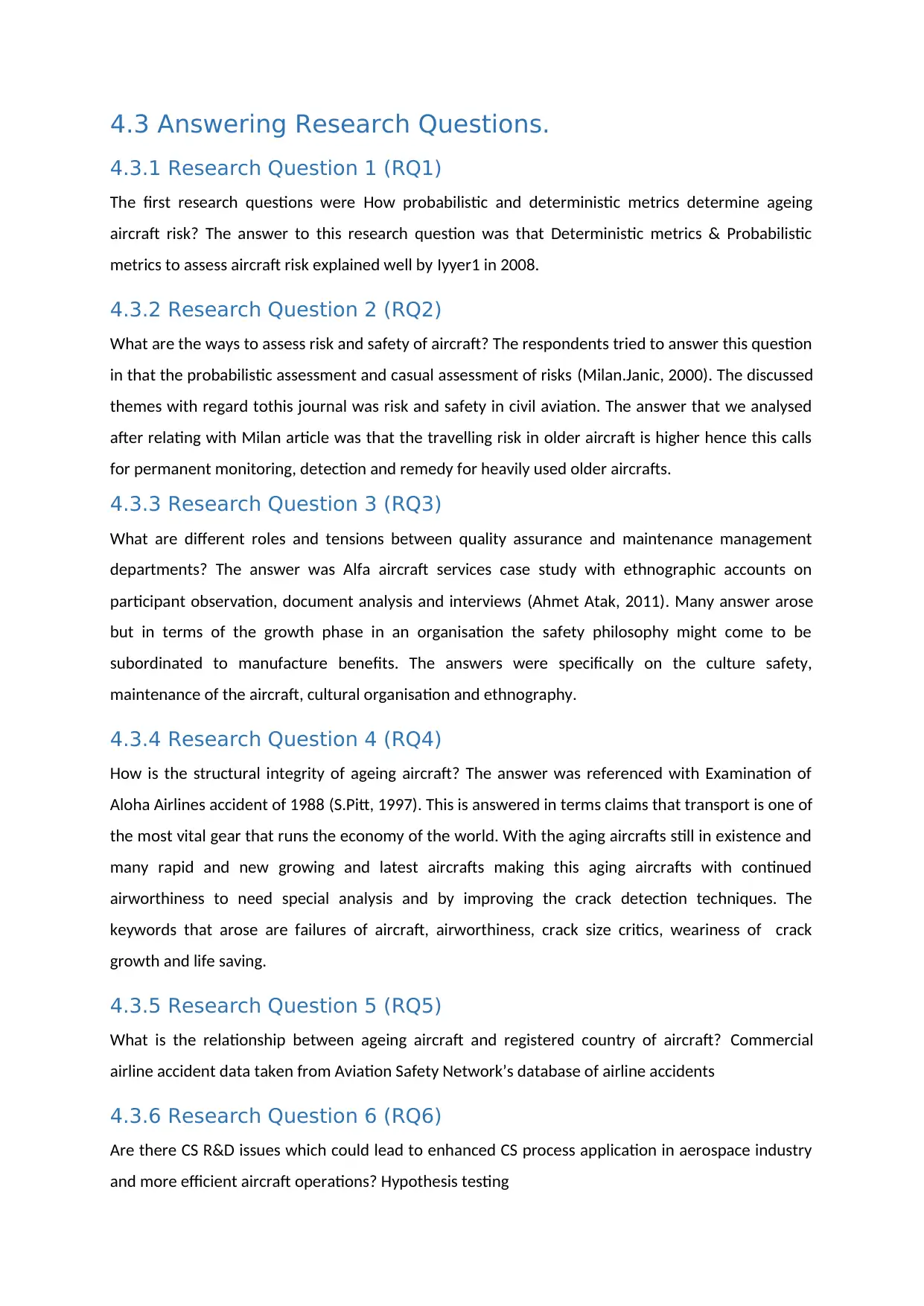
4.3 Answering Research Questions.
4.3.1 Research Question 1 (RQ1)
The first research questions were How probabilistic and deterministic metrics determine ageing
aircraft risk? The answer to this research question was that Deterministic metrics & Probabilistic
metrics to assess aircraft risk explained well by Iyyer1 in 2008.
4.3.2 Research Question 2 (RQ2)
What are the ways to assess risk and safety of aircraft? The respondents tried to answer this question
in that the probabilistic assessment and casual assessment of risks (Milan.Janic, 2000). The discussed
themes with regard tothis journal was risk and safety in civil aviation. The answer that we analysed
after relating with Milan article was that the travelling risk in older aircraft is higher hence this calls
for permanent monitoring, detection and remedy for heavily used older aircrafts.
4.3.3 Research Question 3 (RQ3)
What are different roles and tensions between quality assurance and maintenance management
departments? The answer was Alfa aircraft services case study with ethnographic accounts on
participant observation, document analysis and interviews (Ahmet Atak, 2011). Many answer arose
but in terms of the growth phase in an organisation the safety philosophy might come to be
subordinated to manufacture benefits. The answers were specifically on the culture safety,
maintenance of the aircraft, cultural organisation and ethnography.
4.3.4 Research Question 4 (RQ4)
How is the structural integrity of ageing aircraft? The answer was referenced with Examination of
Aloha Airlines accident of 1988 (S.Pitt, 1997). This is answered in terms claims that transport is one of
the most vital gear that runs the economy of the world. With the aging aircrafts still in existence and
many rapid and new growing and latest aircrafts making this aging aircrafts with continued
airworthiness to need special analysis and by improving the crack detection techniques. The
keywords that arose are failures of aircraft, airworthiness, crack size critics, weariness of crack
growth and life saving.
4.3.5 Research Question 5 (RQ5)
What is the relationship between ageing aircraft and registered country of aircraft? Commercial
airline accident data taken from Aviation Safety Network’s database of airline accidents
4.3.6 Research Question 6 (RQ6)
Are there CS R&D issues which could lead to enhanced CS process application in aerospace industry
and more efficient aircraft operations? Hypothesis testing
4.3.1 Research Question 1 (RQ1)
The first research questions were How probabilistic and deterministic metrics determine ageing
aircraft risk? The answer to this research question was that Deterministic metrics & Probabilistic
metrics to assess aircraft risk explained well by Iyyer1 in 2008.
4.3.2 Research Question 2 (RQ2)
What are the ways to assess risk and safety of aircraft? The respondents tried to answer this question
in that the probabilistic assessment and casual assessment of risks (Milan.Janic, 2000). The discussed
themes with regard tothis journal was risk and safety in civil aviation. The answer that we analysed
after relating with Milan article was that the travelling risk in older aircraft is higher hence this calls
for permanent monitoring, detection and remedy for heavily used older aircrafts.
4.3.3 Research Question 3 (RQ3)
What are different roles and tensions between quality assurance and maintenance management
departments? The answer was Alfa aircraft services case study with ethnographic accounts on
participant observation, document analysis and interviews (Ahmet Atak, 2011). Many answer arose
but in terms of the growth phase in an organisation the safety philosophy might come to be
subordinated to manufacture benefits. The answers were specifically on the culture safety,
maintenance of the aircraft, cultural organisation and ethnography.
4.3.4 Research Question 4 (RQ4)
How is the structural integrity of ageing aircraft? The answer was referenced with Examination of
Aloha Airlines accident of 1988 (S.Pitt, 1997). This is answered in terms claims that transport is one of
the most vital gear that runs the economy of the world. With the aging aircrafts still in existence and
many rapid and new growing and latest aircrafts making this aging aircrafts with continued
airworthiness to need special analysis and by improving the crack detection techniques. The
keywords that arose are failures of aircraft, airworthiness, crack size critics, weariness of crack
growth and life saving.
4.3.5 Research Question 5 (RQ5)
What is the relationship between ageing aircraft and registered country of aircraft? Commercial
airline accident data taken from Aviation Safety Network’s database of airline accidents
4.3.6 Research Question 6 (RQ6)
Are there CS R&D issues which could lead to enhanced CS process application in aerospace industry
and more efficient aircraft operations? Hypothesis testing
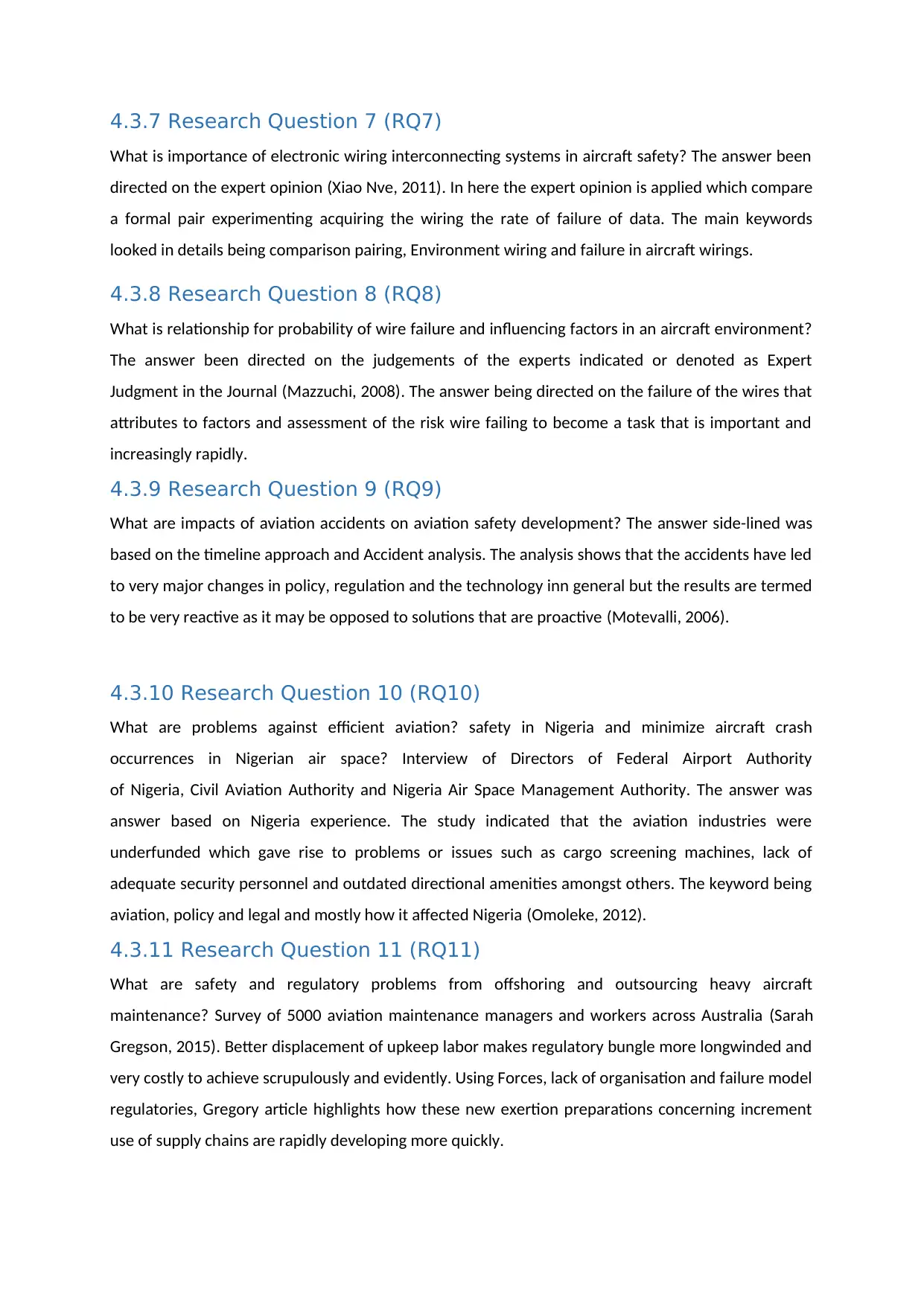
4.3.7 Research Question 7 (RQ7)
What is importance of electronic wiring interconnecting systems in aircraft safety? The answer been
directed on the expert opinion (Xiao Nve, 2011). In here the expert opinion is applied which compare
a formal pair experimenting acquiring the wiring the rate of failure of data. The main keywords
looked in details being comparison pairing, Environment wiring and failure in aircraft wirings.
4.3.8 Research Question 8 (RQ8)
What is relationship for probability of wire failure and influencing factors in an aircraft environment?
The answer been directed on the judgements of the experts indicated or denoted as Expert
Judgment in the Journal (Mazzuchi, 2008). The answer being directed on the failure of the wires that
attributes to factors and assessment of the risk wire failing to become a task that is important and
increasingly rapidly.
4.3.9 Research Question 9 (RQ9)
What are impacts of aviation accidents on aviation safety development? The answer side-lined was
based on the timeline approach and Accident analysis. The analysis shows that the accidents have led
to very major changes in policy, regulation and the technology inn general but the results are termed
to be very reactive as it may be opposed to solutions that are proactive (Motevalli, 2006).
4.3.10 Research Question 10 (RQ10)
What are problems against efficient aviation? safety in Nigeria and minimize aircraft crash
occurrences in Nigerian air space? Interview of Directors of Federal Airport Authority
of Nigeria, Civil Aviation Authority and Nigeria Air Space Management Authority. The answer was
answer based on Nigeria experience. The study indicated that the aviation industries were
underfunded which gave rise to problems or issues such as cargo screening machines, lack of
adequate security personnel and outdated directional amenities amongst others. The keyword being
aviation, policy and legal and mostly how it affected Nigeria (Omoleke, 2012).
4.3.11 Research Question 11 (RQ11)
What are safety and regulatory problems from offshoring and outsourcing heavy aircraft
maintenance? Survey of 5000 aviation maintenance managers and workers across Australia (Sarah
Gregson, 2015). Better displacement of upkeep labor makes regulatory bungle more longwinded and
very costly to achieve scrupulously and evidently. Using Forces, lack of organisation and failure model
regulatories, Gregory article highlights how these new exertion preparations concerning increment
use of supply chains are rapidly developing more quickly.
What is importance of electronic wiring interconnecting systems in aircraft safety? The answer been
directed on the expert opinion (Xiao Nve, 2011). In here the expert opinion is applied which compare
a formal pair experimenting acquiring the wiring the rate of failure of data. The main keywords
looked in details being comparison pairing, Environment wiring and failure in aircraft wirings.
4.3.8 Research Question 8 (RQ8)
What is relationship for probability of wire failure and influencing factors in an aircraft environment?
The answer been directed on the judgements of the experts indicated or denoted as Expert
Judgment in the Journal (Mazzuchi, 2008). The answer being directed on the failure of the wires that
attributes to factors and assessment of the risk wire failing to become a task that is important and
increasingly rapidly.
4.3.9 Research Question 9 (RQ9)
What are impacts of aviation accidents on aviation safety development? The answer side-lined was
based on the timeline approach and Accident analysis. The analysis shows that the accidents have led
to very major changes in policy, regulation and the technology inn general but the results are termed
to be very reactive as it may be opposed to solutions that are proactive (Motevalli, 2006).
4.3.10 Research Question 10 (RQ10)
What are problems against efficient aviation? safety in Nigeria and minimize aircraft crash
occurrences in Nigerian air space? Interview of Directors of Federal Airport Authority
of Nigeria, Civil Aviation Authority and Nigeria Air Space Management Authority. The answer was
answer based on Nigeria experience. The study indicated that the aviation industries were
underfunded which gave rise to problems or issues such as cargo screening machines, lack of
adequate security personnel and outdated directional amenities amongst others. The keyword being
aviation, policy and legal and mostly how it affected Nigeria (Omoleke, 2012).
4.3.11 Research Question 11 (RQ11)
What are safety and regulatory problems from offshoring and outsourcing heavy aircraft
maintenance? Survey of 5000 aviation maintenance managers and workers across Australia (Sarah
Gregson, 2015). Better displacement of upkeep labor makes regulatory bungle more longwinded and
very costly to achieve scrupulously and evidently. Using Forces, lack of organisation and failure model
regulatories, Gregory article highlights how these new exertion preparations concerning increment
use of supply chains are rapidly developing more quickly.
⊘ This is a preview!⊘
Do you want full access?
Subscribe today to unlock all pages.

Trusted by 1+ million students worldwide
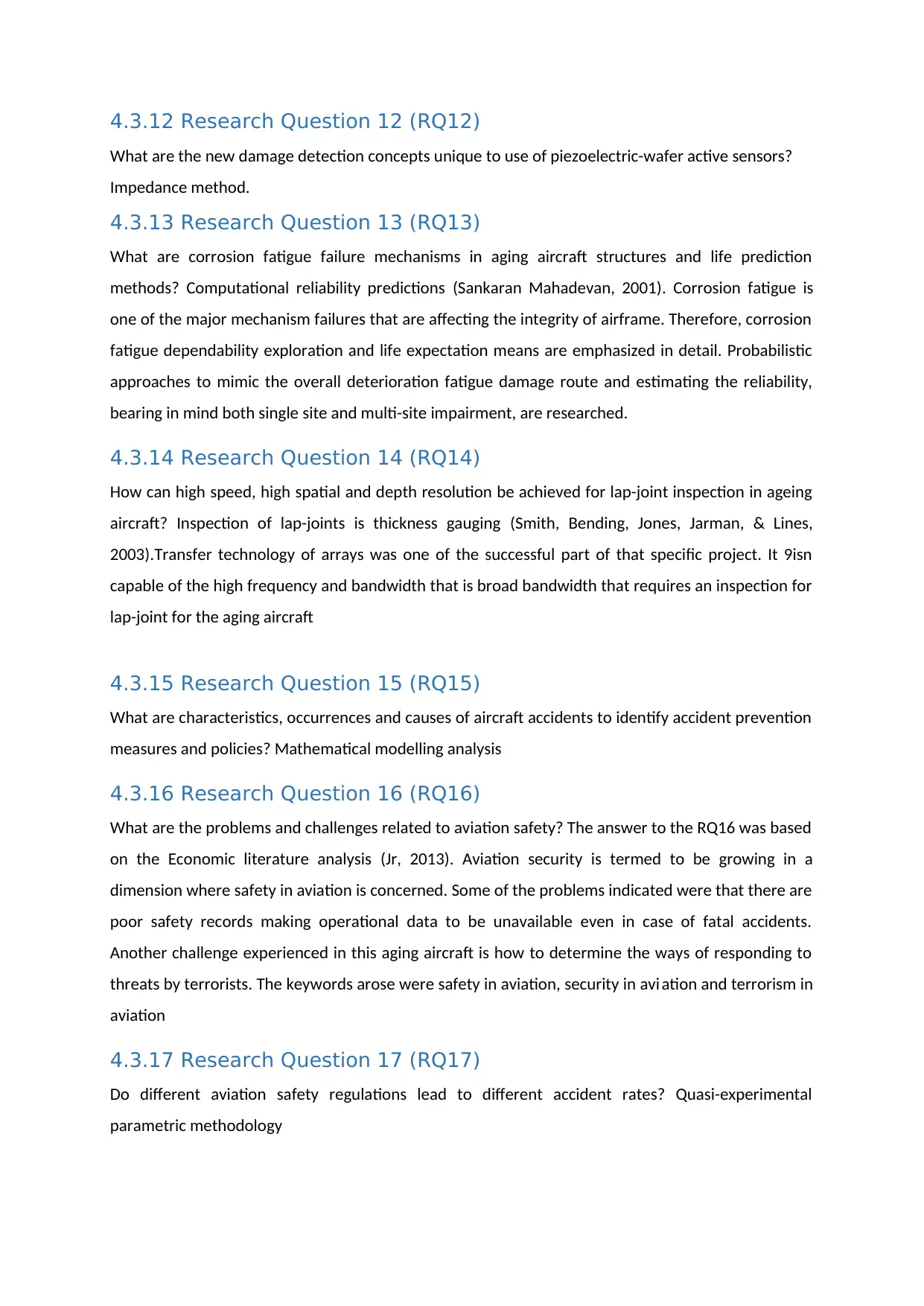
4.3.12 Research Question 12 (RQ12)
What are the new damage detection concepts unique to use of piezoelectric-wafer active sensors?
Impedance method.
4.3.13 Research Question 13 (RQ13)
What are corrosion fatigue failure mechanisms in aging aircraft structures and life prediction
methods? Computational reliability predictions (Sankaran Mahadevan, 2001). Corrosion fatigue is
one of the major mechanism failures that are affecting the integrity of airframe. Therefore, corrosion
fatigue dependability exploration and life expectation means are emphasized in detail. Probabilistic
approaches to mimic the overall deterioration fatigue damage route and estimating the reliability,
bearing in mind both single site and multi-site impairment, are researched.
4.3.14 Research Question 14 (RQ14)
How can high speed, high spatial and depth resolution be achieved for lap-joint inspection in ageing
aircraft? Inspection of lap-joints is thickness gauging (Smith, Bending, Jones, Jarman, & Lines,
2003).Transfer technology of arrays was one of the successful part of that specific project. It 9isn
capable of the high frequency and bandwidth that is broad bandwidth that requires an inspection for
lap-joint for the aging aircraft
4.3.15 Research Question 15 (RQ15)
What are characteristics, occurrences and causes of aircraft accidents to identify accident prevention
measures and policies? Mathematical modelling analysis
4.3.16 Research Question 16 (RQ16)
What are the problems and challenges related to aviation safety? The answer to the RQ16 was based
on the Economic literature analysis (Jr, 2013). Aviation security is termed to be growing in a
dimension where safety in aviation is concerned. Some of the problems indicated were that there are
poor safety records making operational data to be unavailable even in case of fatal accidents.
Another challenge experienced in this aging aircraft is how to determine the ways of responding to
threats by terrorists. The keywords arose were safety in aviation, security in avi ation and terrorism in
aviation
4.3.17 Research Question 17 (RQ17)
Do different aviation safety regulations lead to different accident rates? Quasi-experimental
parametric methodology
What are the new damage detection concepts unique to use of piezoelectric-wafer active sensors?
Impedance method.
4.3.13 Research Question 13 (RQ13)
What are corrosion fatigue failure mechanisms in aging aircraft structures and life prediction
methods? Computational reliability predictions (Sankaran Mahadevan, 2001). Corrosion fatigue is
one of the major mechanism failures that are affecting the integrity of airframe. Therefore, corrosion
fatigue dependability exploration and life expectation means are emphasized in detail. Probabilistic
approaches to mimic the overall deterioration fatigue damage route and estimating the reliability,
bearing in mind both single site and multi-site impairment, are researched.
4.3.14 Research Question 14 (RQ14)
How can high speed, high spatial and depth resolution be achieved for lap-joint inspection in ageing
aircraft? Inspection of lap-joints is thickness gauging (Smith, Bending, Jones, Jarman, & Lines,
2003).Transfer technology of arrays was one of the successful part of that specific project. It 9isn
capable of the high frequency and bandwidth that is broad bandwidth that requires an inspection for
lap-joint for the aging aircraft
4.3.15 Research Question 15 (RQ15)
What are characteristics, occurrences and causes of aircraft accidents to identify accident prevention
measures and policies? Mathematical modelling analysis
4.3.16 Research Question 16 (RQ16)
What are the problems and challenges related to aviation safety? The answer to the RQ16 was based
on the Economic literature analysis (Jr, 2013). Aviation security is termed to be growing in a
dimension where safety in aviation is concerned. Some of the problems indicated were that there are
poor safety records making operational data to be unavailable even in case of fatal accidents.
Another challenge experienced in this aging aircraft is how to determine the ways of responding to
threats by terrorists. The keywords arose were safety in aviation, security in avi ation and terrorism in
aviation
4.3.17 Research Question 17 (RQ17)
Do different aviation safety regulations lead to different accident rates? Quasi-experimental
parametric methodology
Paraphrase This Document
Need a fresh take? Get an instant paraphrase of this document with our AI Paraphraser
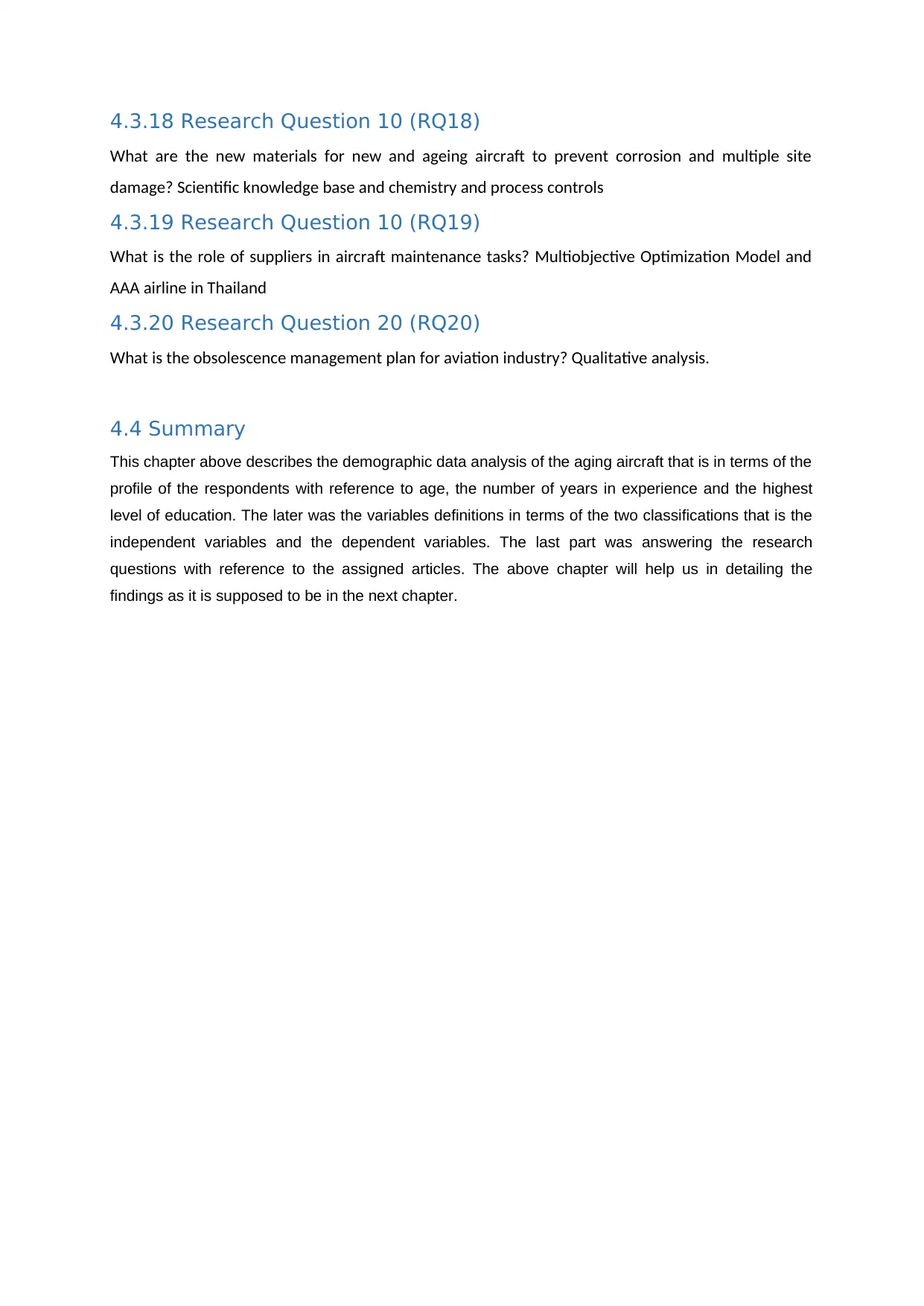
4.3.18 Research Question 10 (RQ18)
What are the new materials for new and ageing aircraft to prevent corrosion and multiple site
damage? Scientific knowledge base and chemistry and process controls
4.3.19 Research Question 10 (RQ19)
What is the role of suppliers in aircraft maintenance tasks? Multiobjective Optimization Model and
AAA airline in Thailand
4.3.20 Research Question 20 (RQ20)
What is the obsolescence management plan for aviation industry? Qualitative analysis.
4.4 Summary
This chapter above describes the demographic data analysis of the aging aircraft that is in terms of the
profile of the respondents with reference to age, the number of years in experience and the highest
level of education. The later was the variables definitions in terms of the two classifications that is the
independent variables and the dependent variables. The last part was answering the research
questions with reference to the assigned articles. The above chapter will help us in detailing the
findings as it is supposed to be in the next chapter.
What are the new materials for new and ageing aircraft to prevent corrosion and multiple site
damage? Scientific knowledge base and chemistry and process controls
4.3.19 Research Question 10 (RQ19)
What is the role of suppliers in aircraft maintenance tasks? Multiobjective Optimization Model and
AAA airline in Thailand
4.3.20 Research Question 20 (RQ20)
What is the obsolescence management plan for aviation industry? Qualitative analysis.
4.4 Summary
This chapter above describes the demographic data analysis of the aging aircraft that is in terms of the
profile of the respondents with reference to age, the number of years in experience and the highest
level of education. The later was the variables definitions in terms of the two classifications that is the
independent variables and the dependent variables. The last part was answering the research
questions with reference to the assigned articles. The above chapter will help us in detailing the
findings as it is supposed to be in the next chapter.
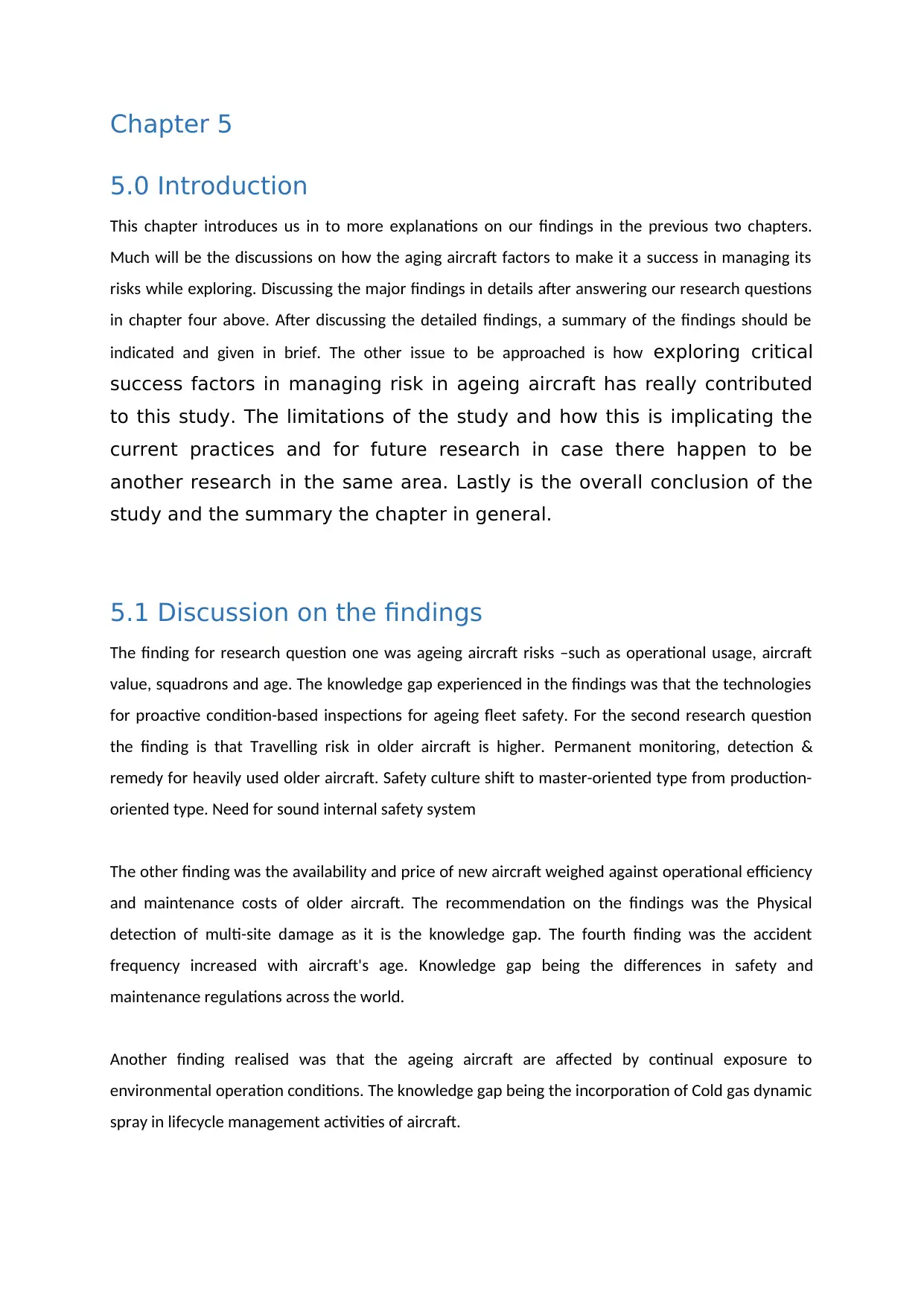
Chapter 5
5.0 Introduction
This chapter introduces us in to more explanations on our findings in the previous two chapters.
Much will be the discussions on how the aging aircraft factors to make it a success in managing its
risks while exploring. Discussing the major findings in details after answering our research questions
in chapter four above. After discussing the detailed findings, a summary of the findings should be
indicated and given in brief. The other issue to be approached is how exploring critical
success factors in managing risk in ageing aircraft has really contributed
to this study. The limitations of the study and how this is implicating the
current practices and for future research in case there happen to be
another research in the same area. Lastly is the overall conclusion of the
study and the summary the chapter in general.
5.1 Discussion on the findings
The finding for research question one was ageing aircraft risks –such as operational usage, aircraft
value, squadrons and age. The knowledge gap experienced in the findings was that the technologies
for proactive condition-based inspections for ageing fleet safety. For the second research question
the finding is that Travelling risk in older aircraft is higher. Permanent monitoring, detection &
remedy for heavily used older aircraft. Safety culture shift to master-oriented type from production-
oriented type. Need for sound internal safety system
The other finding was the availability and price of new aircraft weighed against operational efficiency
and maintenance costs of older aircraft. The recommendation on the findings was the Physical
detection of multi-site damage as it is the knowledge gap. The fourth finding was the accident
frequency increased with aircraft's age. Knowledge gap being the differences in safety and
maintenance regulations across the world.
Another finding realised was that the ageing aircraft are affected by continual exposure to
environmental operation conditions. The knowledge gap being the incorporation of Cold gas dynamic
spray in lifecycle management activities of aircraft.
5.0 Introduction
This chapter introduces us in to more explanations on our findings in the previous two chapters.
Much will be the discussions on how the aging aircraft factors to make it a success in managing its
risks while exploring. Discussing the major findings in details after answering our research questions
in chapter four above. After discussing the detailed findings, a summary of the findings should be
indicated and given in brief. The other issue to be approached is how exploring critical
success factors in managing risk in ageing aircraft has really contributed
to this study. The limitations of the study and how this is implicating the
current practices and for future research in case there happen to be
another research in the same area. Lastly is the overall conclusion of the
study and the summary the chapter in general.
5.1 Discussion on the findings
The finding for research question one was ageing aircraft risks –such as operational usage, aircraft
value, squadrons and age. The knowledge gap experienced in the findings was that the technologies
for proactive condition-based inspections for ageing fleet safety. For the second research question
the finding is that Travelling risk in older aircraft is higher. Permanent monitoring, detection &
remedy for heavily used older aircraft. Safety culture shift to master-oriented type from production-
oriented type. Need for sound internal safety system
The other finding was the availability and price of new aircraft weighed against operational efficiency
and maintenance costs of older aircraft. The recommendation on the findings was the Physical
detection of multi-site damage as it is the knowledge gap. The fourth finding was the accident
frequency increased with aircraft's age. Knowledge gap being the differences in safety and
maintenance regulations across the world.
Another finding realised was that the ageing aircraft are affected by continual exposure to
environmental operation conditions. The knowledge gap being the incorporation of Cold gas dynamic
spray in lifecycle management activities of aircraft.
⊘ This is a preview!⊘
Do you want full access?
Subscribe today to unlock all pages.

Trusted by 1+ million students worldwide
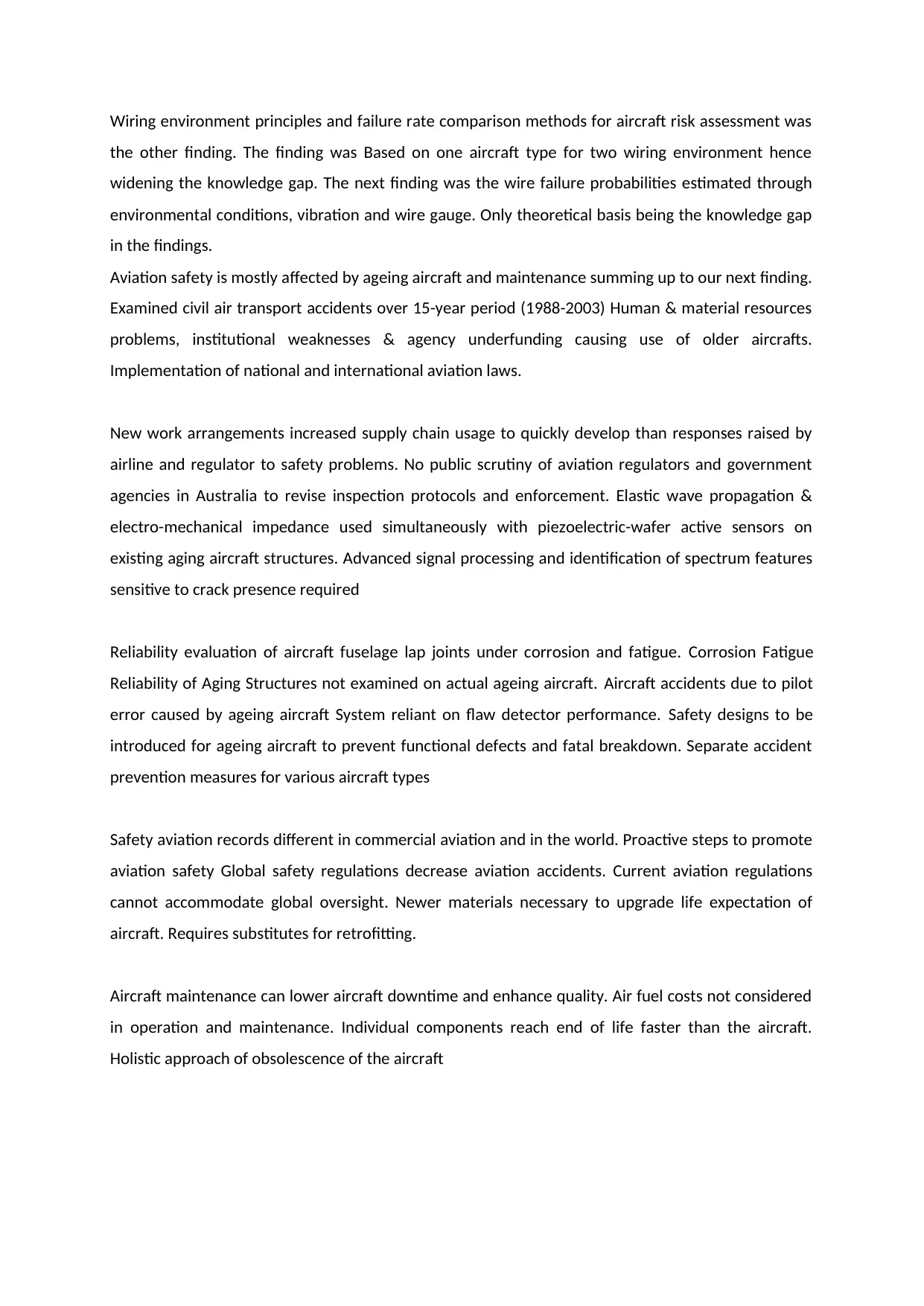
Wiring environment principles and failure rate comparison methods for aircraft risk assessment was
the other finding. The finding was Based on one aircraft type for two wiring environment hence
widening the knowledge gap. The next finding was the wire failure probabilities estimated through
environmental conditions, vibration and wire gauge. Only theoretical basis being the knowledge gap
in the findings.
Aviation safety is mostly affected by ageing aircraft and maintenance summing up to our next finding.
Examined civil air transport accidents over 15-year period (1988-2003) Human & material resources
problems, institutional weaknesses & agency underfunding causing use of older aircrafts.
Implementation of national and international aviation laws.
New work arrangements increased supply chain usage to quickly develop than responses raised by
airline and regulator to safety problems. No public scrutiny of aviation regulators and government
agencies in Australia to revise inspection protocols and enforcement. Elastic wave propagation &
electro-mechanical impedance used simultaneously with piezoelectric-wafer active sensors on
existing aging aircraft structures. Advanced signal processing and identification of spectrum features
sensitive to crack presence required
Reliability evaluation of aircraft fuselage lap joints under corrosion and fatigue. Corrosion Fatigue
Reliability of Aging Structures not examined on actual ageing aircraft. Aircraft accidents due to pilot
error caused by ageing aircraft System reliant on flaw detector performance. Safety designs to be
introduced for ageing aircraft to prevent functional defects and fatal breakdown. Separate accident
prevention measures for various aircraft types
Safety aviation records different in commercial aviation and in the world. Proactive steps to promote
aviation safety Global safety regulations decrease aviation accidents. Current aviation regulations
cannot accommodate global oversight. Newer materials necessary to upgrade life expectation of
aircraft. Requires substitutes for retrofitting.
Aircraft maintenance can lower aircraft downtime and enhance quality. Air fuel costs not considered
in operation and maintenance. Individual components reach end of life faster than the aircraft.
Holistic approach of obsolescence of the aircraft
the other finding. The finding was Based on one aircraft type for two wiring environment hence
widening the knowledge gap. The next finding was the wire failure probabilities estimated through
environmental conditions, vibration and wire gauge. Only theoretical basis being the knowledge gap
in the findings.
Aviation safety is mostly affected by ageing aircraft and maintenance summing up to our next finding.
Examined civil air transport accidents over 15-year period (1988-2003) Human & material resources
problems, institutional weaknesses & agency underfunding causing use of older aircrafts.
Implementation of national and international aviation laws.
New work arrangements increased supply chain usage to quickly develop than responses raised by
airline and regulator to safety problems. No public scrutiny of aviation regulators and government
agencies in Australia to revise inspection protocols and enforcement. Elastic wave propagation &
electro-mechanical impedance used simultaneously with piezoelectric-wafer active sensors on
existing aging aircraft structures. Advanced signal processing and identification of spectrum features
sensitive to crack presence required
Reliability evaluation of aircraft fuselage lap joints under corrosion and fatigue. Corrosion Fatigue
Reliability of Aging Structures not examined on actual ageing aircraft. Aircraft accidents due to pilot
error caused by ageing aircraft System reliant on flaw detector performance. Safety designs to be
introduced for ageing aircraft to prevent functional defects and fatal breakdown. Separate accident
prevention measures for various aircraft types
Safety aviation records different in commercial aviation and in the world. Proactive steps to promote
aviation safety Global safety regulations decrease aviation accidents. Current aviation regulations
cannot accommodate global oversight. Newer materials necessary to upgrade life expectation of
aircraft. Requires substitutes for retrofitting.
Aircraft maintenance can lower aircraft downtime and enhance quality. Air fuel costs not considered
in operation and maintenance. Individual components reach end of life faster than the aircraft.
Holistic approach of obsolescence of the aircraft
Paraphrase This Document
Need a fresh take? Get an instant paraphrase of this document with our AI Paraphraser

5.2 Summary of the findings
The summary of the finding can be briefly explained the following table.
Finding
Risks in ageing aircraft such as, aircraft value and age
Travelling risk in older aircraft is higher
Safety culture shift to master-oriented type from production-oriented type
Availability & price of new aircraft weighed against operational efficiency & maintenance costs of older aircraft
Accident frequency increased with aircraft's age
Ageing aircraft affected by continual exposure to environmental operation conditions
Wiring environment principles and failure rate comparison methods for aircraft risk assessment
Wire failure probabilities estimated through environmental conditions, vibration and wire gauge
Aviation safety affected by ageing aircraft and maintenance
Human & resources problems, institutional weaknesses & agency underfunding causing use of older aircrafts
New work arrangements increased supply chain usage to quickly develop than responses raised by airline and
regulator to safety problems
Elastic wave propagation & electro-mechanical impedance used simultaneously with piezoelectric-wafer active
sensors on existing aging aircraft structures
Reliability evaluation of aircraft fuselage lap joints under corrosion and fatigue
Aircraft accidents due to pilot error caused by ageing aircraft
Safety designs to be introduced for ageing aircraft to prevent functional defects and fatal breakdown
Safety aviation records different in commercial aviation and in the world
Global safety regulations decrease aviation accidents
Newer materials necessary to upgrade life expectation of aircraft
Aircraft maintenance can lower aircraft downtime and enhance quality
5.3 Contribution of the study
One of the contribution that came up was building of a team work within this aviation learning
institution. The other contribution in the study is implementing of systems that are in compatible
with the current technology as this will help in exploring the critical success factors in managing risk
in ageing aircraft.
The summary of the finding can be briefly explained the following table.
Finding
Risks in ageing aircraft such as, aircraft value and age
Travelling risk in older aircraft is higher
Safety culture shift to master-oriented type from production-oriented type
Availability & price of new aircraft weighed against operational efficiency & maintenance costs of older aircraft
Accident frequency increased with aircraft's age
Ageing aircraft affected by continual exposure to environmental operation conditions
Wiring environment principles and failure rate comparison methods for aircraft risk assessment
Wire failure probabilities estimated through environmental conditions, vibration and wire gauge
Aviation safety affected by ageing aircraft and maintenance
Human & resources problems, institutional weaknesses & agency underfunding causing use of older aircrafts
New work arrangements increased supply chain usage to quickly develop than responses raised by airline and
regulator to safety problems
Elastic wave propagation & electro-mechanical impedance used simultaneously with piezoelectric-wafer active
sensors on existing aging aircraft structures
Reliability evaluation of aircraft fuselage lap joints under corrosion and fatigue
Aircraft accidents due to pilot error caused by ageing aircraft
Safety designs to be introduced for ageing aircraft to prevent functional defects and fatal breakdown
Safety aviation records different in commercial aviation and in the world
Global safety regulations decrease aviation accidents
Newer materials necessary to upgrade life expectation of aircraft
Aircraft maintenance can lower aircraft downtime and enhance quality
5.3 Contribution of the study
One of the contribution that came up was building of a team work within this aviation learning
institution. The other contribution in the study is implementing of systems that are in compatible
with the current technology as this will help in exploring the critical success factors in managing risk
in ageing aircraft.
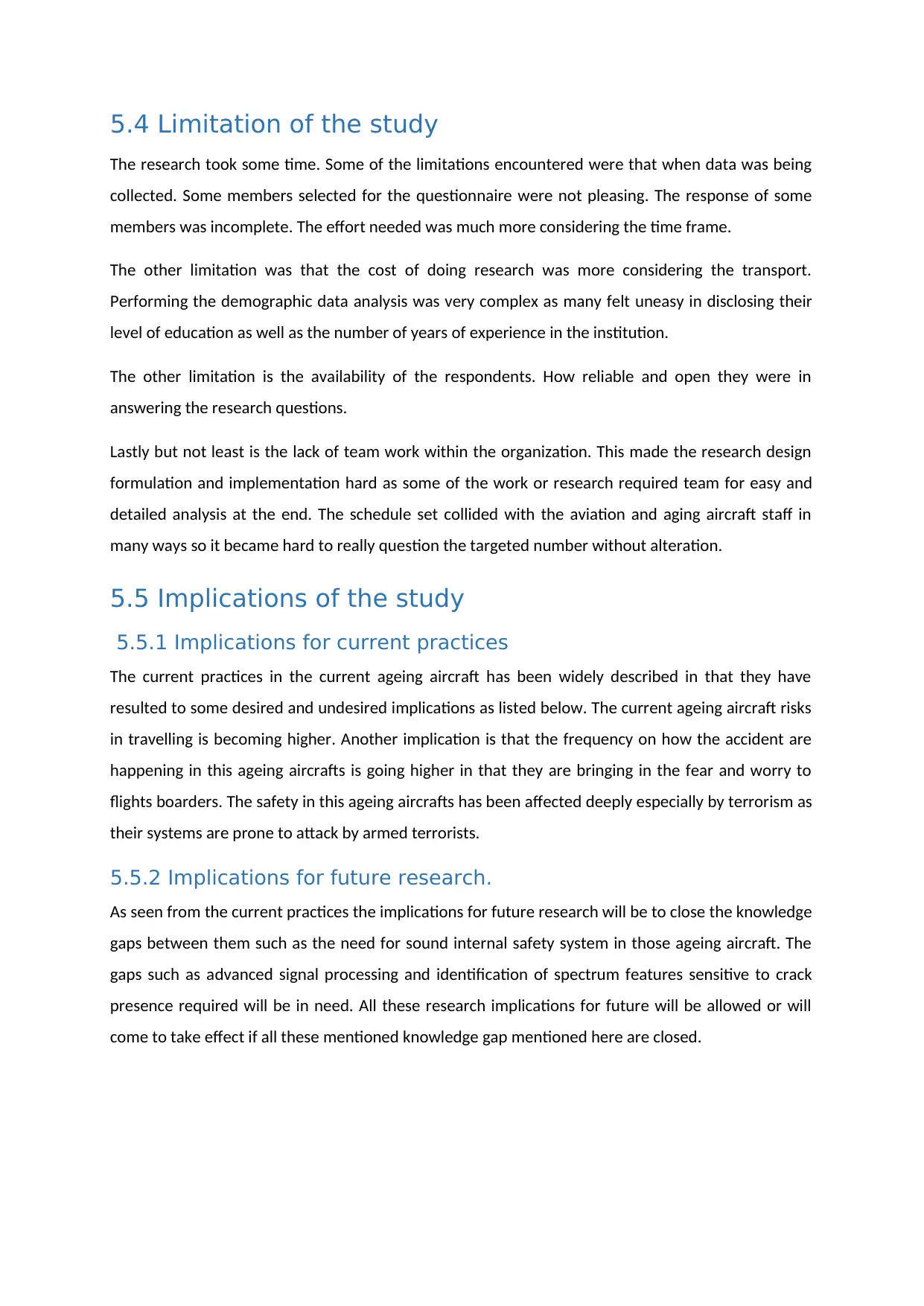
5.4 Limitation of the study
The research took some time. Some of the limitations encountered were that when data was being
collected. Some members selected for the questionnaire were not pleasing. The response of some
members was incomplete. The effort needed was much more considering the time frame.
The other limitation was that the cost of doing research was more considering the transport.
Performing the demographic data analysis was very complex as many felt uneasy in disclosing their
level of education as well as the number of years of experience in the institution.
The other limitation is the availability of the respondents. How reliable and open they were in
answering the research questions.
Lastly but not least is the lack of team work within the organization. This made the research design
formulation and implementation hard as some of the work or research required team for easy and
detailed analysis at the end. The schedule set collided with the aviation and aging aircraft staff in
many ways so it became hard to really question the targeted number without alteration.
5.5 Implications of the study
5.5.1 Implications for current practices
The current practices in the current ageing aircraft has been widely described in that they have
resulted to some desired and undesired implications as listed below. The current ageing aircraft risks
in travelling is becoming higher. Another implication is that the frequency on how the accident are
happening in this ageing aircrafts is going higher in that they are bringing in the fear and worry to
flights boarders. The safety in this ageing aircrafts has been affected deeply especially by terrorism as
their systems are prone to attack by armed terrorists.
5.5.2 Implications for future research.
As seen from the current practices the implications for future research will be to close the knowledge
gaps between them such as the need for sound internal safety system in those ageing aircraft. The
gaps such as advanced signal processing and identification of spectrum features sensitive to crack
presence required will be in need. All these research implications for future will be allowed or will
come to take effect if all these mentioned knowledge gap mentioned here are closed.
The research took some time. Some of the limitations encountered were that when data was being
collected. Some members selected for the questionnaire were not pleasing. The response of some
members was incomplete. The effort needed was much more considering the time frame.
The other limitation was that the cost of doing research was more considering the transport.
Performing the demographic data analysis was very complex as many felt uneasy in disclosing their
level of education as well as the number of years of experience in the institution.
The other limitation is the availability of the respondents. How reliable and open they were in
answering the research questions.
Lastly but not least is the lack of team work within the organization. This made the research design
formulation and implementation hard as some of the work or research required team for easy and
detailed analysis at the end. The schedule set collided with the aviation and aging aircraft staff in
many ways so it became hard to really question the targeted number without alteration.
5.5 Implications of the study
5.5.1 Implications for current practices
The current practices in the current ageing aircraft has been widely described in that they have
resulted to some desired and undesired implications as listed below. The current ageing aircraft risks
in travelling is becoming higher. Another implication is that the frequency on how the accident are
happening in this ageing aircrafts is going higher in that they are bringing in the fear and worry to
flights boarders. The safety in this ageing aircrafts has been affected deeply especially by terrorism as
their systems are prone to attack by armed terrorists.
5.5.2 Implications for future research.
As seen from the current practices the implications for future research will be to close the knowledge
gaps between them such as the need for sound internal safety system in those ageing aircraft. The
gaps such as advanced signal processing and identification of spectrum features sensitive to crack
presence required will be in need. All these research implications for future will be allowed or will
come to take effect if all these mentioned knowledge gap mentioned here are closed.
⊘ This is a preview!⊘
Do you want full access?
Subscribe today to unlock all pages.

Trusted by 1+ million students worldwide
1 out of 15
Related Documents
Your All-in-One AI-Powered Toolkit for Academic Success.
+13062052269
info@desklib.com
Available 24*7 on WhatsApp / Email
![[object Object]](/_next/static/media/star-bottom.7253800d.svg)
Unlock your academic potential
Copyright © 2020–2025 A2Z Services. All Rights Reserved. Developed and managed by ZUCOL.





